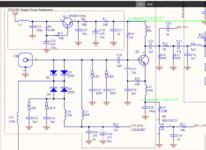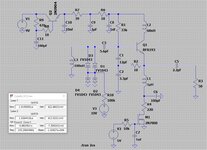Mahruz
Junior Member level 3
Hi All,
I am stuck in understanding why the below VCO circuit does not oscillate marked in red colour box.
I tried changing the transistor but, still, there is no oscillation.
For a good PCB; after testing and checking at C10 in a spectrum analyser; I roughly get -10dBm.
Is there a method to simulate the below circuit in AWR or LTspice or so ?

Thanks,
Mahruz
I am stuck in understanding why the below VCO circuit does not oscillate marked in red colour box.
I tried changing the transistor but, still, there is no oscillation.
For a good PCB; after testing and checking at C10 in a spectrum analyser; I roughly get -10dBm.
Is there a method to simulate the below circuit in AWR or LTspice or so ?
Thanks,
Mahruz

